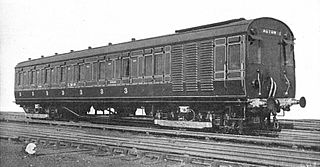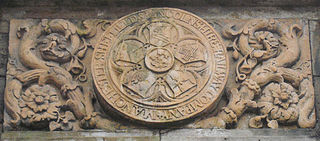The London, Midland and Scottish Railway (LMS) was created under the terms of the Railways Act 1921. The first schedule to that Act listed four groups, and for each, a number of "Constituent Companies" were listed, as were a number of subsidiary companies. The constituent companies would amalgamate to create a new railway company, and the subsidiary companies would be absorbed either by one of the constituent companies prior to the amalgamation, or by the new railway company after amalgamation. The group that was to become the LMS was described in the Act as "the North Western, Midland and West Scottish Group". [1]
The following made up the London, Midland and Scottish Railway as a result of the Railways Act 1921:
Independently operated lines
Independent lines for which rolling stock was provided by other companies
Non-working companies
The Railways Act 1921 did not extend to Ireland, but Irish lines owned by constituent companies became part of the LMS:

The London and North Western Railway was a British railway company between 1846 and 1922. In the late 19th century, the LNWR was the largest joint stock company in the world.

The London, Midland and Scottish Railway (LMS) was a British railway company. It was formed on 1 January 1923 under the Railways Act 1921, which required the grouping of over 120 separate railways into four. The companies merged into the LMS included the London and North Western Railway, the Midland Railway, the Lancashire and Yorkshire Railway, several Scottish railway companies, and numerous other, smaller ventures.

The Stratford-upon-Avon and Midland Junction Railway (SMJR) was a railway company in the southern Midlands of England, formed at the beginning of 1909 by the merger of three earlier companies:

The Midland Railway (MR) was a railway company in the United Kingdom from 1844. The Midland was one of the largest railway companies in Britain in the early 20th century, and the largest employer in Derby, where it had its headquarters. It amalgamated with several other railways to create the London, Midland and Scottish Railway at grouping in 1923.

The Lancashire and Yorkshire Railway (L&YR) was a major British railway company before the 1923 Grouping. It was incorporated in 1847 from an amalgamation of several existing railways. It was the third-largest railway system based in northern England.

The North Staffordshire Railway (NSR) was a British railway company formed in 1845 to promote a number of lines in the Staffordshire Potteries and surrounding areas in Staffordshire, Cheshire, Derbyshire and Shropshire.

The London, Midland and Scottish Railway (LMS) was involved in the development of railway electrification of Britain. Like the LNER and the SR the LMS took over several schemes that had been developed by its constituent companies and also completed some of its own. All were suburban lines, in London, Liverpool and Manchester, and were usually steam lines converted to electric traction. Each service is listed below, showing dates of opening and the railway responsible for its conversion.

The Manchester, Sheffield and Lincolnshire Railway (MS&LR) was formed in 1847 when the Sheffield, Ashton-under-Lyne and Manchester Railway joined with authorised but unbuilt railway companies, forming a proposed network from Manchester to Grimsby. It pursued a policy of expanding its area of influence, especially in reaching west to Liverpool, which it ultimately did through the medium of the Cheshire Lines Committee network in joint partnership with the Great Northern Railway and the Midland Railway.

The Cambrian Railways owned 230 miles (370 km) of track over a large area of mid Wales. The system was an amalgamation of a number of railways that were incorporated in 1864, 1865 and 1904. The Cambrian connected with two larger railways with connections to the northwest of England via the London and North Western Railway, and the Great Western Railway for connections between London and Wales. The Cambrian Railways amalgamated with the Great Western Railway on 1 January 1922 as a result of the Railways Act 1921. The name is continued today in the route known as the Cambrian Line.

A joint railway is a railway operating under the control of more than one railway company.
A number of different numbering and classification schemes were used for the locomotives owned by the London, Midland and Scottish Railway (LMS) and its constituent companies.

The history of rail transport in Great Britain 1830–1922 covers the period between the opening of the Liverpool and Manchester Railway (L&MR), and the Grouping, the amalgamation of almost all of Britain's many railway companies into the Big Four by the Railways Act 1921.

The York and North Midland Railway (Y&NMR) was an English railway company that opened in 1839 connecting York with the Leeds and Selby Railway, and in 1840 extended this line to meet the North Midland Railway at Normanton near Leeds. Its first chairman was the railway financier George Hudson, who had been called the railway king.
The Shrewsbury and Hereford Railway was an English railway company that built a standard gauge line between those places. It opened its main line in 1853.

The Birkenhead Railway was a railway company in North West England. It was incorporated as the Birkenhead, Lancashire and Cheshire Junction Railway (BL&CJR) in 1846 to build a line connecting the port of Birkenhead and the city of Chester with the manufacturing districts of Lancashire by making a junction near Warrington with the Grand Junction Railway. The BL&CJR took over the Chester and Birkenhead Railway in 1847, keeping its own name for the combined company until it shortened its name to the Birkenhead Railway in 1859. It was taken over jointly, on 1 January 1860, by the London and North Western Railway (LNWR) and the Great Western Railway (GWR). It remained a joint railway until nationalisation of the railways in 1948.